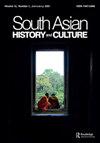Indo-German exchanges in education: Rabindranath Tagore meets Paul and Edith Geheeb
IF 0.3
0 ASIAN STUDIES
引用次数: 0
Abstract
protectionism in contemporary India, suggesting a through-line between historical discourses and present-day conflicts. However, the spread of these discourses outside Bengal, and the popularization of animal protectionism beyond the middle class are largely absent from the text. Given that West Bengal today is one of the only eight Indian states without a full or partial beef ban, the shifting geographies and social spaces of the contestation of human–animal relations – and especially human–cow relations – merit attention. The degree to which present-day class contours of animal protection, whether cow-focused or otherwise, parallel or diverge from their colonial-era antecedents also requires further attention. I raise these questions of contemporary parallels and divergences not because I think that Samanta’s book needed to answer them, but rather because she evokes them in her introduction, and because they are suggestive of potential future areas of study. But Meat, Mercy, Morality itself tells a remarkably complete and compelling story of the varied contestations of human-animal relations in colonial Bengal. The book is particularly commendable for, as Samanta puts it, ‘taking the South Asian context as the norm’, as a way to challenge ‘hegemonic’ practices in the writing of global history. The book is a useful model for other scholars because it avoids the assumption that European narratives of animal protectionism were universal, or that South Asia deviated from some expected ‘Western’ process. At the same time, its writing style and narrative remain accessible, even for readers without a significant background in the history of Bengal. Likewise, the book will be useful for a wide range of historians because it provides a model for the close analysis of multiple distinct colonial-era archives. Samanta weaves together a cohesive narrative by drawing on sources ranging from Bengali-fiction to official records and colonial memoirs. Through this diverse array of materials, she effectively demonstrates that although animal protection and cruelty discourses claimed to centre the suffering of non-human animals, they were ultimately used to legitimize colonial racial, class, and social hierarchies, and indeed, the colonial state itself.印德教育交流:泰戈尔会见Paul和Edith Geheeb夫妇
当代印度的保护主义,暗示了历史话语和当今冲突之间的一条贯穿线。然而,这些话语在孟加拉以外的传播,以及动物保护主义在中产阶级之外的普及,在很大程度上都没有出现在文本中。考虑到今天的西孟加拉邦是印度仅有的八个没有完全或部分禁止牛肉的邦之一,人与动物关系——尤其是人与牛的关系——争论的地理和社会空间的变化值得关注。无论是以牛为中心还是以其他方式,当今阶级对动物保护的看法与殖民时代的前辈在多大程度上是相似的还是不同的,这也需要进一步关注。我提出这些当代的相似和分歧的问题,不是因为我认为萨曼塔的书需要回答这些问题,而是因为她在她的引言中唤起了这些问题,因为它们暗示了未来潜在的研究领域。但《肉,慈悲,道德》本身讲述了一个非常完整和引人注目的故事,讲述了殖民时期孟加拉人与动物关系的各种争论。正如萨曼塔所说,这本书特别值得称赞的是,它“把南亚的背景作为规范”,作为挑战全球历史写作中“霸权”做法的一种方式。这本书对其他学者来说是一个有用的模型,因为它避免了欧洲关于动物保护主义的叙述是普遍的,或者南亚偏离了一些预期的“西方”进程的假设。与此同时,它的写作风格和叙述仍然易于理解,即使对没有孟加拉历史背景的读者也是如此。同样,这本书也将对许多历史学家有用,因为它为深入分析多个不同的殖民时代档案提供了一个模型。萨曼塔利用从孟加拉小说到官方记录和殖民回忆录的各种资料,编织出一个有凝聚力的叙事。通过这些多样化的材料,她有效地表明,尽管动物保护和虐待话语声称以非人类动物的痛苦为中心,但它们最终被用来使殖民地的种族、阶级和社会等级,甚至殖民地国家本身合法化。
本文章由计算机程序翻译,如有差异,请以英文原文为准。
求助全文
约1分钟内获得全文
求助全文

 求助内容:
求助内容: 应助结果提醒方式:
应助结果提醒方式:


